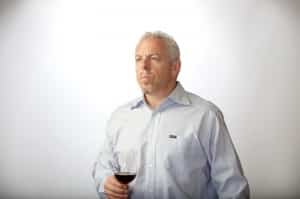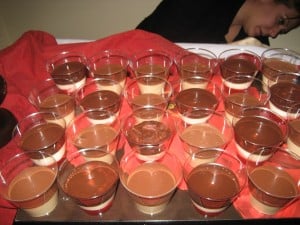Archive for February, 2010
Consider Yourself Paired – “Yinzer Torte”!
First of all, I want to mention that it’s really great that Daniel is using local resources as his ingredients. It’s really sad that people are so urbanized and removed from nature that they don’t even trust the fruit that grows on their local trees! Just like Daniel used the local quinces for this recipe, I have often thought about using the ginkgo “stinky” fruit that falls from the female trees that are common all over Washington, D.C. Stinky Gingko Fruit – unfortunately, it is SO stinky, that it will probably never happen!
The first point I want to make is that I am not a proponent of pairing dessert wines and dessert – the way I see it, there’s a missing synergy. In my book (sorry for the blatant promo!) I Drink on the Job – I have a complete chapter on pairing wine and food, and the principle that comes to mind is “1+1=1/2”. It seems weird, but when you put a sweet food in your mouth and then you drink a sweet beverage (it could be any beverage – fruit juice, cola, etc.), the sweetness is significantly reduced. The pairing rule I often learned was that the wine should be at least as sweet at the dessert, but I don’t see how it makes a difference – sweet and sweet mostly cancel each other out!
Another point is that the Yinzer torte is made with highly acidic quince fruit turned into a butter emulsion. So now you have acidity – and yes, you do want to match a dishes acidity with the wine, or the wine will taste really flat! You could easily pair this dish with a traditional dessert wine like a Sauternes or a Hungarian Tokaj, and that will do just fine. But let me throw a curve ball.
1) I prefer to have contrast to a sweet dessert dish – just like many people really enjoy coffee with sweets because the tannin in coffee contrasts the sweetness of dessert on your palate, I would rather pair this with a spirit – and my spirit of choice for this dish is either a Cognac or a Calvados. Cognac is distilled from grapes and has a nice fruit component. Calvados is distilled from apples and has that fruit component as well. You could have a whisky or a Scotch, but definitely avoid a really smoky/peaty version of the latter – there are no smoke components to this dessert (unless you’re puffing on a cigar at the time!),
2) Change the dish a bit to make it go better with wine – this is called a pairing “bridge”. For example, you could put some chopped walnuts on top and maybe serve with a slice of blue cheese and now Ruby Port goes perfectly! Crunchy nuts would also add texture which makes food more interesting on the palate. Add a caramel sauce, and now a Tawny port, which is port that has been pre-aged in barrel will work with those flavors. You could even bridge this dessert by making a dessert wine reduction, and that would bring the flavors together.
3) Add fresh whipped cream with a little liqueur in it like Cointreau. OK, it won’t match better with any wine, but certainly it will make the dish all the better, and isn’t pleasure what you’re really after?
Consider yourself paired!
Charlie Adler, Author, I Drink on the Job
If You Evaluate Wine, Then Why Not Food?
This was a crazy week for me, so I’m just starting to wind down and think about it more. I was on the “Thunder Show” with Gary V on Monday (although it went up on Wednesday), traveled back to DC through the snow and began in earnest to market my book the rest of the week, with a small respite for a “Unique Spirits 101” class that I organized with my full-time gig TasteDC. I always like to look back at my week and try to sift through what was important, what I learned and if I need to avoid any situations. I sort of live in a bubble – all I care about is promoting my message – wine and food were meant to be together – and that’s become my life goal, better not get in the way!
I love wine, and I love food, so I’m in a bit of a quandary (a common state for me!)..why is it in the wine world that we try to evaluate and break down wine, but in the food world, it only happens in rare occasions such as competitions..a little vague, but let me explain. Whenever I’m teaching a class on wine like my “Wine Basics 101” class at TasteDC, attendees always ask me to “explain” what I’m tasting. People who are attending a wine class obviously want to learn more about wine, but I’m not sure why they want to know what I’m tasting – does it translate well to their taste buds? If I taste spearmint, blackberry and tobacco, and you taste peppermint, cranberry and honey, who’s right? By breaking down the components of the “taste” of wine, do I make it any easier for a beginner wine drinker to understand the wine? Will the attendee be empowered by the experience or intimidated, and ultimately, will it get the person to purchase more wine?
First of all, I don’t have the answer, that’s why I’m in a quandary – there is no answer, sometimes just looking at the question brings awareness to the situation (my Zen side!). So I posed an additional question to myself: if we break down wine into its individual parts, shouldn’t we do so for food as well? In my book “I Drink on the Job” I spend alot of time talking about the connection between food and wine. I have one quote – read it, consider it, make a picture of it in your mind:
Americans don’t seem to trust their sense of taste with wine. If you like steak, then you don’t need anyone to tell you if it’s good or not; you’ve enjoyed steak since you were young and you know what you like–medium or medium-rare, one-inch thick, two-inch, rib eye, filet or strip–even if someone else disagrees. We have no experience with wine as a culture, so we seek peer approval..
I Drink Launches on Wine Library TV with Gary V!
Charlie Adler with Gary Vaynerchuk on Official Launch of “I Drink on the Job” Book
OK, time for “I Drink on the Job”s 15 minutes of fame..it all started on a cold rainy day, windswept and forlorn..
Actually, I met Gary V on his “Crush It” book tour when he visited American University in Washington, D.C.
Crush It has had a huge influence on my book marketing via Social Media..
I give Gary V credit, he’s a very savvy guy, and being on the show is about the most exhilarating experience I’ve ever had,
I mean it’s like an emotional roller-coaster, it was scary and fun at the same time!
I’ll have more on this tomorrow – I’m watching I Drink Amazon.com Sales go through the roof!!
Chocolate and Wine: A Pairing for Sweeties!
I love chocolate..I love wine..but can the two come together to make a great match? This is the dilemma of writing a chocolate and wine pairing article – it is not a “traditional” pairing, meaning, it is neither a regional pairing (Loire Valley Sauvignon Blanc and Chevre) nor a dish pairing such as steak and Cabernet Sauvignon. Chocolate and wine pairing was created primarily to satisfy the need for accentuating and justifying the obvious connection between being amorous and enjoying the sensual pleasures of chocolate and vino!
Actually, the pairing can work, so here’s my take on the combination. First, the assumption is you’ll be tasting dark chocolate, in other words, chocolate with say 60% or more Cacao percent. Dark chocolate or “bittersweet” chocolate has two components to think about: tannin (from the cacao bean) and sugar. The basics of food and wine pairing are either to pair similar or contrasting components. For example, since chocolate has tannin and red wine has tannin, you could pair those flavors. The effect of pairing similar tastes is actually to lessen each, also known as “1+1=1/2”. Take too similar “tastes” paired together and that component will be lessened. Tannin and tannin reduce the effects of each other. This same principle works with the sugar in chocolate and the sugar in a glass of wine, again the same thing, this will ultimately make both seem less sweet. This is a weird phenomenon, but try something basic like orange juice and a sweet morning muffin, and it becomes obvious.
If you contrast with your pairing, the most obvious is to pair a highly acidic wine with chocolate to counterbalance the tannin and/or sweetness. In my opinion, this won’t work very well because it would be an unnecessary overload of the senses. Plus, I’ve tried it, and it tastes pretty awful or neutral at best!
So you have a choice: you can either pair the sweetness with a dessert wine such as a French Sauternes or a German dessert Riesling or you can pair the tannin in chocolate with a red wine with tannin. For whatever reason, many Merlots and also fruity medium tannin wines work with chocolate. Merlot is generally medium tannin, but also has softer, lusher tannins that don’t seem to clash with chocolate.
So what’s my conclusion after evaluating the chocolate and wine pairing principles? Frankly, it’s better to just go with the romantic mood, forget the pairing and enjoy some delicious Champagne or sparkling wine with chocolate! My reasoning is the power of suggestion: sparkling wine suggests a special occasion, from the popping of the cork to the effervescence of the wine, and it promotes the romantic occasion.
You could play with the sparkling wine a bit by serving a Rosé which often is made from lightly pressed and fermented Pinot Noir. The best pairing might be Port which has both tannin from the red grapes as well as sweetness from sugar. My issue with Port is that from experience, many Americans aren’t fond of it, especially at tastings I’ve held, it is often over powering to an unaccustomed palate.
Conclusion: wine and food pairing shouldn’t get in the way of a romantic moment, they should accentuate it. Dessert wines work great with the sugar of chocolate, Port is even better, but medium tannin wines like Merlot also work well..still, Champagne or sparkling wine wines. Celebrate love and romance with a bottle of bubbly and share the moment!
How To Taste Wine – Strange Faults
Sometimes wine doesn’t smell and taste like it should right out of the bottle..
Sometimes you get cork taint, and even that can be difficult to detect..
Tasting wine takes practice and experience, but anyone can figure out wine – it’s more about understanding what a wine normally tastes like and how outside factors such as a faulty cork, overheating and wine production issues ultimately effect the wine.
One conclusion I’ve come to is it’s better to drink wine younger rather than aged – many faults occur from aging and/or are accentuated. Drink younger and fresher wines, and you’re more likely to enjoy the fruit and lively acidity, with older wines, you never know..but there are rewards to aging!
Charlie “I Drink on the Job” Adler







